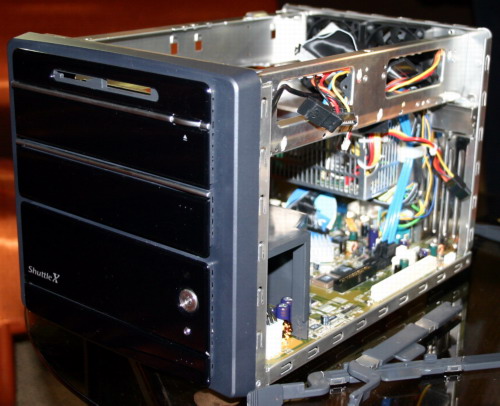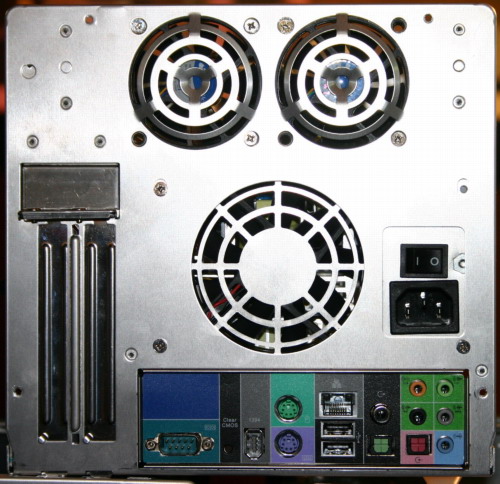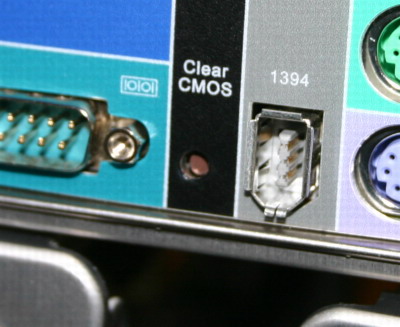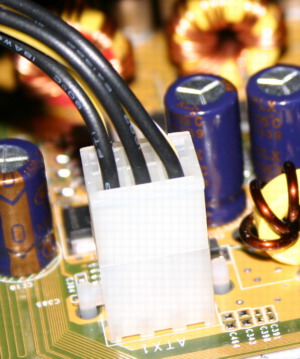Computex 2004: BTX at the Show
by Anand Lal Shimpi on June 2, 2004 7:17 AM EST- Posted in
- Trade Shows
Shuttle: Better than BTX?
Although Shuttle was showing off a BTX SFF at Intel's showcase, they had their own version of the BTX standard on display in their latest SFF based on Intel's 925X chipset:

Shuttle's 925X SFF employs many BTX-like features, but others that Shuttle claims make it "better than BTX." For starters, the system has a smaller form factor than even a picoBTX based system could achieve.

Note the three fans at the back. The larger one in the middle is for the 350W PSU, the two at the top are dedicated fans for the two hard drive bays at the top of the case.
What's also very nice is the inclusion of a clear CMOS button at the back of the case, a feature Shuttle introduced with their Zen platform:

Having a clear CMOS button on the back helps avoid dealing with setting a jumper in the cramped internals (as clean as they may be on the Shuttle box).
The two connectors below are another unique feature of the 925X based SFF PC:

The connector to the left is a 4-pin fan connector (we'll get to why it's 4 pins in a bit), the connector to the right is actually a 4-pin PCI Express x1 connector - a proprietary connector that Shuttle implemented. Why include a custom PCI Express connector on the motherboard? In the event that Shuttle comes up with a unique location of a PCI Express expansion slot, run a cable to this connector and you've got instant PCI Express anywhere in the chassis. Shuttle will probably offer a cleaner connector if they decide to actually use this thing.
The PCI Express connector isn't the only unique thing about Shuttle's like-BTX box; this connector is Shuttle's version of the 4-pin 12V ATX power connector for CPUs:

Shuttle's connector has 3 x 12V lines and 3 ground lines, and is necessary because Shuttle does not use a standard power supply connector setup for this system.










28 Comments
View All Comments
srg - Thursday, June 3, 2004 - link
Another thing, there are hardly any expansion slots compaired to ATX, I don't care about these tiny systems, I want expansion.srg
Kai920 - Thursday, June 3, 2004 - link
#9,YES! Those new Shuttles have me droooling all over. I'm waiting for the new SN95 (AMD 939) in a G5 chassis... estimate waiting time would be another year from now before prices fall to my desired levels.
tfranzese - Thursday, June 3, 2004 - link
#15, BTX has no relavence to going smaller and quieter. It's biggest benefit is cooling and even then you can reap much of the benefits by just having things rearranged in an ATX case as demonstrated by Lian-Li.Xentropy - Thursday, June 3, 2004 - link
Wow. I've never seen so much opposition to smaller, cooler cases. As a regular LAN gamer and overclocking enthusiest, both changes are quite welcome to me.I generally build a system every year, and generally buy a new case each time anyway. That said, I'm set to build out a system in a couple of months now, but it probably won't be BTX thanks to a dearth of availability. However, I'm hoping it catches on so my 2005 system can be smaller, lighter, quieter, and more overclockable.
Other than having to buy a new case to enjoy these benefits (and even if there were a smaller ATX design, you'd STILL need to buy a case for it to be smaller...what are they going to do, sell you a shrink ray to make your existing case smaller?) I see no drawbacks to the new design. And no one's forcing anyone to buy anything; it's just the smart way to go for a NEW purchase--or will be when they're available. I'm sure ATX isn't going to vanish the moment BTX starts being mass-produced. You can even still find AT cases and power supplies pretty easily years after that standard became ancient.
The arguments that this isn't "necessary" for an AMD system are silly. It isn't *necessary* for an Intel one, either; it's just better. And it would even be better for an AMD system. If you overclock, you'd get a few more speed steps or a lower Vcore; if not, you'd get a cooler case ambient temperature and longer theoretical system life.
I'm sure the trace length issue will be solved; I only hope it won't involve AMD designing *another* spec (CTX?) and causing even more of a stir. In a perfect world, AMD and Intel would actually sit on a panel *together* to design this sort of thing (we have standards committees for everything else, why not motherboard and case layout?) and we'd get a design that was both friendly to on-die memory control *and* allowed for another few degrees cooler computing and a few pounds shaved off that hunk of metal I have to sling over my shoulder now and then. Alas, the world isn't perfect, so one of them has to step up and be the "bad guy" and try to improve technology. Of course, if AMD were doing it they wouldn't be bad at all; it would suddenly be the best thing since 64-bit. The "underdog" psychological phenomenon is an interesting one.
tfranzese - Wednesday, June 2, 2004 - link
Lian-Li has the best option IMO. An ATX case with zones much like the BTX and mac case layouts.StrangerGuy - Wednesday, June 2, 2004 - link
Just like the 9xx chipsets. No AGP? Only PCI-E? I was like thinking WTF. Many of us here have quite a lot money spent on our AGP cards, and many of these cards are 9700/9800/5900/X800s which is still very capable for the time being.Even if Intel needed to push PCI-E, at the very least give us a transitionary product so we can keep our AGP cards and upgrade to a PCI-E one some time later.
But now Intel wants us abandon our ATX casings, motherboards, AGP video cards if we wanted a Intel-based CPU upgrade just for this silly BTX spec, which the advantages still remain unproven. Result? Almost everyone
flock to A64s or AXPs. Bottom line? Less people buy Intel.
epiv - Wednesday, June 2, 2004 - link
Can Intel just improve the ATX standard or create a new standard competible with ATX? I beleive it is possible to design a new standard that have all the benefit of BTX and still competitlbe with ATX.Intel loves to ignore other people's investment. They have failed many time for this reason. For example, Rambus which is a lot more expensive than DDR because memory manufacturer cannot use exist equipement to produce and test Rambus memory. Also Itanium which cannot rum 32 bit program well which most company invest a lot money on.
sprockkets - Wednesday, June 2, 2004 - link
The ATX standard has been around since 1997 or so. Remember that with the AT standard there was no real i/o ports, and most of the stuff was in front of the pci/isa slots. And the power button was not full logic either. That right there was a nice improvement: Having computers with the ability to turn on and off without pushing buttons.shabby - Wednesday, June 2, 2004 - link
4 of the mobo's pictures have the power connecter above the x16 slot.... whose idea was that?!?Zak - Wednesday, June 2, 2004 - link
Two intake fans at the side next to PCI and AGP and one exhaust at the very top helps to relive the PCI/AGP/CPU heat buidup in an ATX case. Plus if there are two 8mm fans on the back, as in Chieftec cases, it helps. Sure it can get noisy if you pick lousy/cheap fans.Zak